Global Brain Transcriptome Analysis of a Tpp1 Neuronal Ceroid Lipofuscinoses Mouse Model
- PMID: 31003587
- PMCID: PMC6475859
- DOI: 10.1177/1759091419843393
Global Brain Transcriptome Analysis of a Tpp1 Neuronal Ceroid Lipofuscinoses Mouse Model
Abstract
In humans, homozygous mutations in the TPP1 gene results in loss of tripeptidyl peptidase 1 (TPP1) enzymatic activity, leading to late infantile neuronal ceroid lipofuscinoses disease. Using a mouse model that targets the Tpp1 gene and recapitulates the pathology and clinical features of the human disease, we analyzed end-stage (4 months) transcriptional changes associated with lack of TPP1 activity. Using RNA sequencing technology, Tpp1 expression changes in the forebrain/midbrain and cerebellum of 4-month-old homozygotes were compared with strain-related controls. Transcriptional changes were found in 510 and 1,550 gene transcripts in forebrain/midbrain and cerebellum, respectively, from Tpp1-deficient brain tissues when compared with age-matched controls. Analysis of the differentially expressed genes using the Ingenuity™ pathway software, revealed increased neuroinflammation activity in microglia and astrocytes that could lead to neuronal dysfunction, particularly in the cerebellum. We also observed upregulation in the production of nitric oxide and reactive oxygen species; activation of leukocyte extravasation signals and complement pathways; and downregulation of major transcription factors involved in control of circadian rhythm. Several of these expression changes were confirmed by independent quantitative polymerase chain reaction and histological analysis by mRNA in situ hybridization, which allowed for an in-depth anatomical analysis of the pathology and provided independent confirmation of at least two of the major networks affected in this model. The identification of differentially expressed genes has revealed new lines of investigation for this complex disorder that may lead to novel therapeutic targets.
Keywords: circadian rhythm; lysosomal tripeptidyl peptidase 1; neuroinflammation; neuronal ceroid lipofuscinoses; pediatric neurodegeneration; transcriptome.
Figures



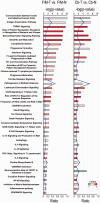

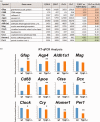
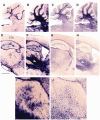
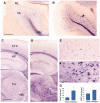
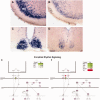
Similar articles
-
A novel CLN2/TPP1 mutation in a patient with late infantile neuronal ceroid lipofuscinosis.Neurol Sci. 2015 Oct;36(10):1917-9. doi: 10.1007/s10072-015-2272-4. Epub 2015 Jun 2. Neurol Sci. 2015. PMID: 26032578 No abstract available.
-
Mutation update: Review of TPP1 gene variants associated with neuronal ceroid lipofuscinosis CLN2 disease.Hum Mutat. 2019 Nov;40(11):1924-1938. doi: 10.1002/humu.23860. Epub 2019 Jul 26. Hum Mutat. 2019. PMID: 31283065 Free PMC article.
-
Multifocal retinopathy in Dachshunds with CLN2 neuronal ceroid lipofuscinosis.Exp Eye Res. 2015 May;134:123-32. doi: 10.1016/j.exer.2015.02.012. Epub 2015 Feb 16. Exp Eye Res. 2015. PMID: 25697710 Free PMC article.
-
Homozygous missense TPP1 mutation associated with mild late infantile neuronal ceroid lipofuscinosis and the genotype-phenotype correlation.Seizure. 2019 Jul;69:180-185. doi: 10.1016/j.seizure.2018.08.027. Epub 2018 Sep 2. Seizure. 2019. PMID: 31059981
-
CLN2 Disease (Classic Late Infantile Neuronal Ceroid Lipofuscinosis).Pediatr Endocrinol Rev. 2016 Jun;13 Suppl 1:682-8. Pediatr Endocrinol Rev. 2016. PMID: 27491216 Review.
Cited by
-
Brain transcriptome analysis of a CLN2 mouse model as a function of disease progression.J Neuroinflammation. 2021 Nov 8;18(1):262. doi: 10.1186/s12974-021-02302-z. J Neuroinflammation. 2021. PMID: 34749772 Free PMC article.
-
Molecular networking in the neuronal ceroid lipofuscinoses: insights from mammalian models and the social amoeba Dictyostelium discoideum.J Biomed Sci. 2020 May 20;27(1):64. doi: 10.1186/s12929-020-00653-y. J Biomed Sci. 2020. PMID: 32430003 Free PMC article. Review.
-
Analysis of Brain and Cerebrospinal Fluid from Mouse Models of the Three Major Forms of Neuronal Ceroid Lipofuscinosis Reveals Changes in the Lysosomal Proteome.Mol Cell Proteomics. 2019 Nov;18(11):2244-2261. doi: 10.1074/mcp.RA119.001587. Epub 2019 Sep 9. Mol Cell Proteomics. 2019. PMID: 31501224 Free PMC article.
-
Chemistry and Function of Glycosaminoglycans in the Nervous System.Adv Neurobiol. 2023;29:117-162. doi: 10.1007/978-3-031-12390-0_5. Adv Neurobiol. 2023. PMID: 36255674 Review.
-
Glial Dysfunction and Its Contribution to the Pathogenesis of the Neuronal Ceroid Lipofuscinoses.Front Neurol. 2022 Apr 4;13:886567. doi: 10.3389/fneur.2022.886567. eCollection 2022. Front Neurol. 2022. PMID: 35444603 Free PMC article. Review.
References
-
- Abreu T., Braganca , M. (2015). The bipolarity of light and dark: A review on bipolar disorder and circadian cycles. J Affect Disord, 185, 219–229. - PubMed
-
- Akiyama H., Nishimura T., Kondo H.Ikeda, K., Hayashi, Y., & McGeer, P. L. (1994). Expression of the receptor for macrophage colony stimulating factor by brain microglia and its upregulation in brains of patients with Alzheimer’s disease and amyotrophic lateral sclerosis. Brain Res, 639, 171–174. - PubMed
-
- Anderson G. W., Goebel H. H., Simonati , A. (2013). Human pathology in NCL. Biochim Biophys Acta, 1832, 1807–1826. - PubMed
-
- Andrews S. (2010). FastQC: A quality control tool for high throughput sequence data Retrieved from http://www.bioinformatics.babraham.ac.uk/projects/fastqc/
-
- Bevan R. J., Evans R., Griffiths L.Watkins, L. M., Rees, M. I., Magliozzi, R., Allen, I., McDonnell, G., Kee, R., Naughton, M., Fitzgerald, D. C., Reynolds, R., Neal, J. W., & Howell, O. W. (2018). Meningeal inflammation and cortical demyelination in acute multiple sclerosis. Ann Neurol, 84, 829–842. - PubMed
Publication types
MeSH terms
Substances
Grants and funding
LinkOut - more resources
Full Text Sources
Molecular Biology Databases

